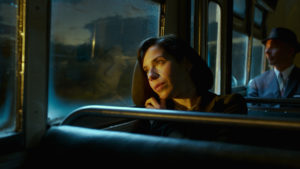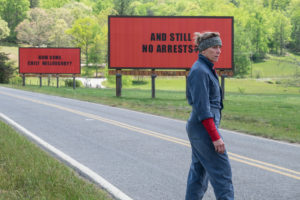2017 has been a bad year for the film industry, but an outstanding year for film itself. With films like The Shape of Water, which earned 13 Oscar nominations, one of the most in history, and social-thriller and crowd favorite Get Out, there is no shortage of beautiful and fascinating stories to watch play out on the big screen. Below are 6 of my must-see films from the last 6 months.
Call Me by Your Name
Call Me by Your Name is a slow-paced film that follows the budding romance between Elio (Timothee Chalamet), a 17 year old on summer break, and Oliver (Armie Hammer), a graduate student working with Elio’s father for the summer. Based on the book by André Aciman and directed by Luca Guadagnino, Call Me by Your Name provoked much discussion upon its November release as one of the most acclaimed “gay” movies ever. But the beauty, and the importance, of the film is that it is not a film about being gay, or even coming out. Instead it is a film about falling in love, and it just happens to be between two men. Neither Elio or Oliver explicitly state their sexuality during the film, and both seem to be rather fluid, defying labels and convention, and in that it might be considered revolutionary. Call Me by Your Name takes place in a gorgeous town in Northern Italy and provokes both profound joy and utter heartbreak as romance unfolds between the two protagonists. Guadagnino expertly employs long shots that linger until the viewer feels uncomfortable, a challenge to look beyond the surface and deeply feel something. Call Me by Your Name is beautiful in every way, from its bright visuals of the Italian countryside to its portrayal of first love, and there is no question that we need more films like it.

I, Tonya
I, Tonya is the hilarious and fast paced biopic based on the life of a woman America loves to hate: figure skater Tonya Harding. Brilliantly directed by Craig Gillespie, Margot Robbie stuns as Harding alongside Allison Janney, who is delightfully hateable as Harding’s mother. Particularly compelling about I, Tonya is that it is just as much a commentary on class in America as it is a documentation of Harding’s figure skating career; despite being the first
woman to land a triple axel in competition, Harding is never able to make up for her working class upbringing in the eyes of figure skating judges and fans. I, Tonya follows Harding’s life from her first skating lesson to her involvement in the assault on fellow skater and American sweetheart Nancy Kerrigan. Tonya Harding’s story is an American classic, and the stylistic choices Gillespie brings to the film keep it fresh. Gillespie incorporates a perfectly executed interview based storytelling format, and often has actors break the fourth wall and speak directlyto the audience. While we may never know the absolute truth of Harding’s story, I, Tonya is an engaging, gritty, dark comedy that does its namesake justice.
Lady Bird
Lady Bird, written and directed by Greta Gerwig, is one of the best coming of age films in recent history, earning its place beside other great works like Richard Linklater’s Boyhood and Barry Jenkins’ Moonlight. This is due in part to Gerwig’s ability to take a familiar story and turn it into something new, quirky, and tender, and in part to a fabulous cast headed by Saoirse Ronan as self-named teen “Lady Bird” and Laurie Metcalf as her mother. The film follows Lady Bird through her final year of high school as she struggles to figure out who she is, a turbulent search that often puts her at odds with her mother who struggles to genuinely communicate with Lady Bird. The lovable Lady Bird is determined to be something more than she is, and is often too invested in her own problems and self image to appreciate everything she already has. Gerwig’s artistic stamp is particularly evident in the choppy and often perfectly awkward dialogue which invokes many laughs. Lady Bird is a charming and touching story about learning to love what you have just when you have to leave it. The film is sure to resonate with anyone who didn’t know exactly who they wanted to be in high school, and will charm even those who did.
The Post
The Post does exactly what it sets out to do: tell the story of a newspaper and its leaders’ moral dilemma as they decide whether to publish a report that exposes the governments cover up of what really happened in Vietnam. The film is hardly anything new artistically. Not that it should be; The Post isn’t trying to be that kind of movie. Instead it very successfully tells the story of the conflicted publisher Katharine Graham of The Washington Post, played by Meryl Streep, and her staff headed by the Editor Ben Bradlee, played by Tom Hanks. The film shines in its nuanced portrayal of heroine Graham, expertly crafted by Streep and Spielberg, neither playing to common feminist or “woman of the time” tropes. Instead, Streep perfectly captures Graham’s inner conflict as she is caught between the warnings of her lawyers that publishing the Pentagon
Papers would destroy the paper and lead to the arrest of herself and other staff, and her passionate belief that the papers must be published to save American democracy and journalism. The Post raises questions about the importance of freedom of the press and journalistic integrity and the dangers of federal overreach that are relevant to the current political and journalistic climate. Just like the writing in the newspaper on which it is based, The Post is presented by director Steven Spielberg in a very “tell it how it is,” style, apart from its trademark Spielberg dramatic, idealized climax supplemented by a roaring score, much like the final shot of the film itself in which the freshly printed papers ascend victoriously toward the ceiling of the warehouse. The Post is perfect for viewers who might enjoy a classic, no-nonsense film, which provides insight on an important but seldom remembered event in U.S. history.

Photo Courtesy of the Shape of Water press kit
The Shape of Water
Guillermo del Toro’s The Shape of Water is out of the ordinary. Or rather, it is extraordinary. The film, which stars Sally Hawkins as Elisa, a mute woman who spends her nights as a cleaning lady at a government lab, is a story of the “other.” When scientists at the lab bring in a human-like sea monster found in the Amazon, they are convinced it holds secrets that will give them a technological advantage in a Cold War world. They subject it to “tests” which are, in fact, torture. Elisa, intrigued by the humanity she sees in the monster, begins to interact with it through small gestures and eventually helps him escape. Living together in the world, they fall in love. Sally Hawkins’ ability to act through expression and gesture alone is phenomenal, and The Shape of Water’s graphics team did an impeccable job creating the monster of del Toro’s imagination, which expresses itself through its eyes and gestures. The blue-green color palette of its gorgeous scales is a beautiful touch; from the opening scene of a house underwater we are transported into a world that is a blend of earth and water. While the film explores the idea of what is “other,” it does so in a very self-aware way that pushes the viewer to look past the expected and question their own ideas about humanity and love.

Photo courtesy of the Three Billboards Outside Ebbing, Missouri press kit
Three Billboards Outside Ebbing, Missouri
Three Billboards Outside Ebbing, Missouri is the pleasant surprise of this awards season. The black comedy directed and meticulously written by Martin McDonagh is full of fabulous disturbing characters that each play their part to contribute to the equally compelling plot. Mildred Hayes, played by Frances McDormand in knockout performance, is a mother grieving the death of her murdered daughter. Hayes is angry that the police have not been able to track
down her daughter’s killer. She channels her emotions into a crusade against the Ebbing, Missouri police department that begins when she rents three billboards and paints them with a message that calls out the Ebbing police department. Hayes is a heroine of multiple dimensions, and some may question if she should be considered a heroine at all. Three Billboards has been the subject of some controversy, as some critics have argued that it tells the story of undeserved redemption on the part of Dixon, cop played by Sam Rockwell. However, these criticisms don’t see Three Billboards for what it really is–a nuanced look at human nature. Three Billboards stands out because there is no clear delineation between the good and bad. Instead, McDonagh manages to create a film with human characters who reveal their worst sides but still provoke some sympathy in the viewer. But that’s what makes this film great.






